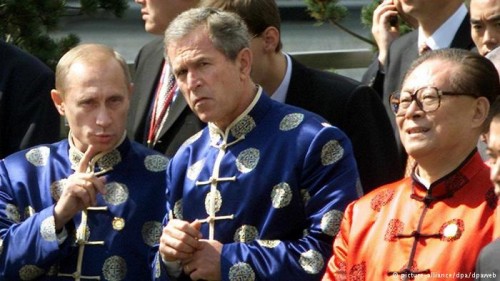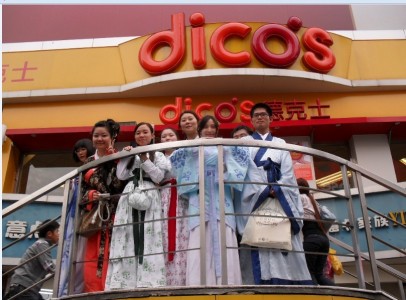The Quest to Find a Garment to Embody China’s Majority
Stepping onto the crowded subway on my commute home, I noticed a girl wearing a type of dress that stood out even amongst the sea of sharply dressed people. The flowing skirt and billowing sleeves of the outfit reflected a style that I’d never seen before.
I later found out that her dress was inspired by Hanfu (汉服), a sartorial phenomenon that has only recently emerged in China.
Global Roots of the Movement

In 2001, world leaders met in Beijing for the Asia-Pacific Economic Cooperation (APEC) summit and donned silk jackets in the Tangzhuang style. Chinese observers were quick to point out the clothing’s similarity to the Manchu magua, which would only represent China’s last ruling Qing dynasty. Thus, a summit representing globalization became the impetus to find a new outfit for China’s majority population, which would cumulate in the Hanfu movement.
A netizen on Baidu Tieba forums recalls her first experience with Hanfu. She was an elementary school student who was looking at a picture of all the ethnic groups in China. China officially has 55 minority groups, but ethnically Han Chinese comprise of more than 90% of China’s population. Upon reflection, she realized that out of all the ethnicities, only the Han representative lacked a distinctive garment. As a Han Chinese, this netizen wanted to wear something that represented her people. Her desire for more recognition of the Han culture reflects the broader motivation behind people’s search of ways to adopt Hanfu into their daily lives.
Conflicts Often Arise at the Crossroads Between Identity and Politics

The concept of Hanfu is a modern invention; this term, describing clothing worn by Chinese before the Qing dynasty, was only invented in the 21st century. Those who wear Hanfu clothing seek to connect with their culture by reviving past customs. Some Hanfu practitioners want to take the celebration of Han culture a step further, by calling for greater integration of the clothing into public life, and thus the Hanfu movement started.
Vocal members of the Hanfu movement have tried to gain public acknowledgment of Hanfu with little success. Their proposal to have Hanfu be the official clothing of the Chinese team during the 2008 Summer Olympics was rejected by the Olympic Committee. Officials are reluctant to make the Hanfu representative of China because it would mean drowning out the voices of other minorities.
However, Hanfu has not been favorably received by all Chinese citizens. Some criticize the accuracy of recreations made by young people who may not be well versed in Chinese history. Others believe that the long robes are too impractical to be used outside of festivals or special occasions. Hanfu wearers have also been the targets of public ire when their clothing was misidentified. In a particularly infamous incident, a girl wearing Hanfu in Chengdu had her robes forcibly removed and burned by a crowd of college students who thought she was wearing a kimono instead. Such misunderstandings show that the Hanfu movement is still relegated to a small segment of the population.
… But the Movement is Gaining Greater Acceptance

This year, the Central Committee of the Communist Youth League (CCCYL) organized the first official Traditional Chinese Garment Day, which encouraged people to post photos of themselves in traditional costumes over social media. Due to the popularity of the event, organizers decided to make the event an annual one. Few people wear Hanfu on a regular basis today, but a simple search of 汉服 on Taobao yields thousands of seller results, a far cry from the early years of the movement where people often had to draft and sew their own patterns.
It is clear that Hanfu wearing cannot be divorced from the prevailing theme of nationalism. Some members of the Hanfu movement want to make the Hanfu the national costume, but most wearers do so to identify with their ethnicity. Although Hanfu can convey the desire for a homogenous and closed off society, showing off pride in one’s cultural heritage doesn’t necessarily have to come at the cost of excluding others. China’s neighbors Korea and Japan have already deep established customs of wearing their national costumes. The Hanbok and Kimono are after all, relatives of the Hanfu.
Sources: China Daily, Baidu Hanfu Tieba
Read more about the historical context behind tensions between China and Japan here.
Indulge in a virtual shopping spree on our e-commerce site, where variety and value collide. From home essentials to cutting-edge electronics, we’ve got something for every taste and preference